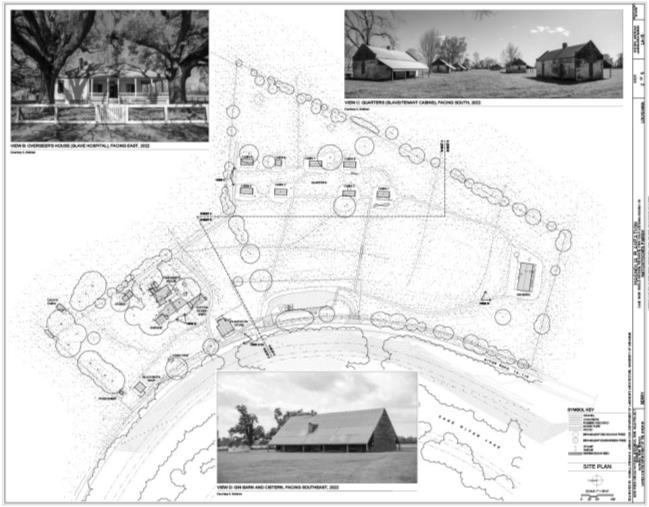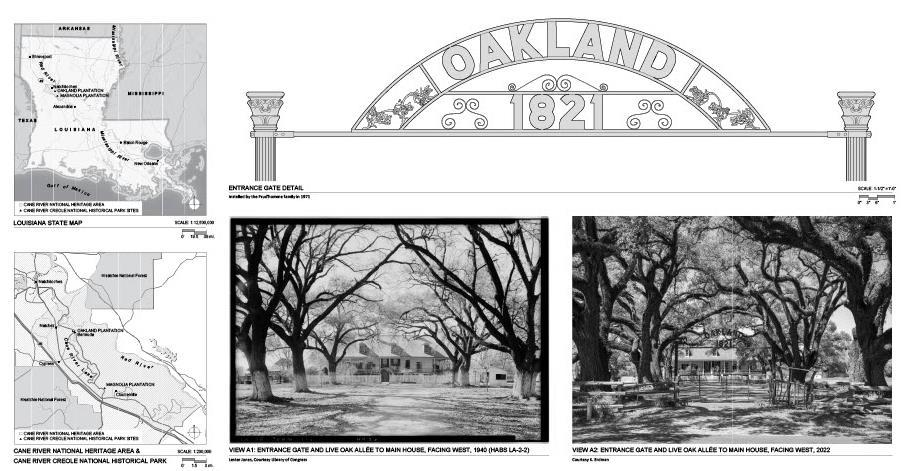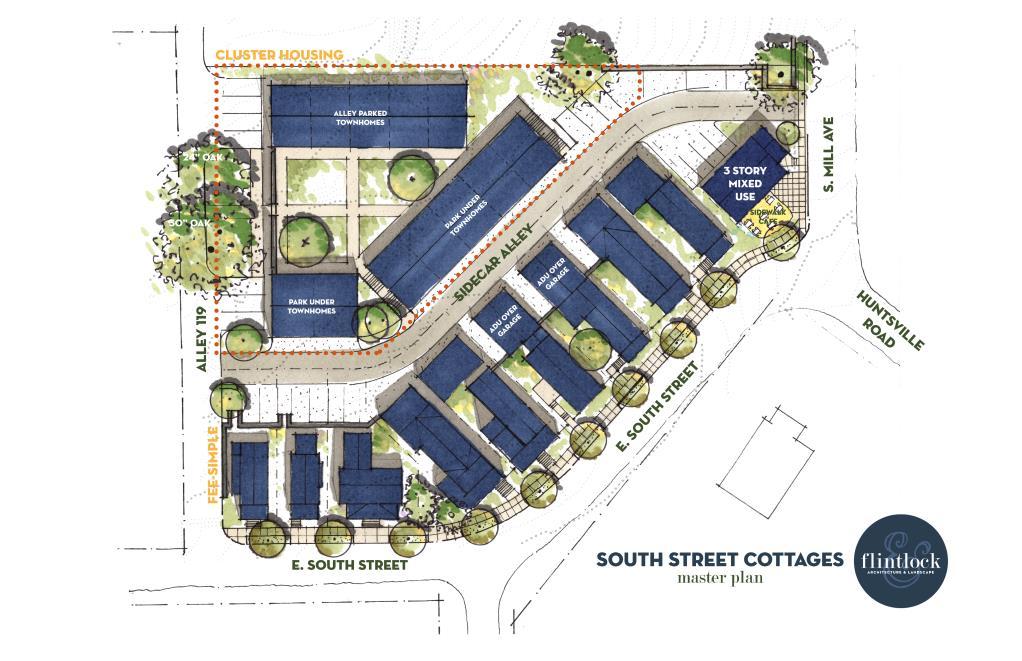
5 minute read
FlintlockLAB
The South Street Cottages neighborhood in a small infill project in Fayetteville, AR, fully designed and developed by one team. The project is being constructed in multiple small phases, with three of five phases completed to date The project’s long timeline has allowed for a range of neighborhood advocacy projects. Highlights have included the city’s first approved tactical urbanism project, improving a dangerous intersection adjacent to the project with the design input of the Yvonne Richardson Community Center’s after school kids program. The entitlement process began with a pop-up petting zoo with the Greedy Goats (who had been onsite for the month to clear invasive honeysuckle. Locally made Pedal Pops were given out as a way to estimate attendance and support the neighboring small business.
The neighborhood’s custom street section promotes walkability, neighbor connection between pedestrians and front porches, and slower traffic speeds. Custom street tree plantings are informed by the data yielded from the Bartlett Tree Laboratory Field Testing for urban tree soil options, optimizing a buildable, affordable, low-tech solution It provides adequate cubic footage of native topsoil for Overcup Oaks, combined with root paths from the tree wells into the adjacent residential landscapes. Elimination of the typical structural soil detail had yielded nearly double the foliage volume of similar street tree plantings elsewhere in the neighborhood.
Advertisement
Each home’s front garden planting is unique and designed within a tight color palette coordinated with the house to provide year-round interest and variety for pedestrians. The site's heavy clay soil presented a challenge to selecting a wide range of low maintenance mostly native plant selections. Evergreen structure is provided throughout the gardens via a mix of native hollies (Foster Holly, American Holly, and Eagleston Holly), magnolias (Little Gem, Alta, and Sweetbay), and junipers (Taylor Juniper and Moonglow Juniper) The formality of the garden designs varies between houses, ranging from hydrangea hedges to a perennial and tallgrass mixed bed. Turfgrass is used extremely sparingly, with side yards provided with large native gravel for stormwater storage and filtration that can withstand the wear and tear of pets in small urban yards. The 1.5-acre site is designed to mitigate a steep existing slope (18% across the site) with a series of terraced spaces among the homes. A central spine new alley allows rear loading of all the units to preserve the street frontage for front porches and pedestrians.
This project shows the potential for more intentional and elegant landscape design as a value add to spec development at a range of price points. The high-performance landscape elevates the beauty and functionality of the public realm of the project, with an equal focus of design attention to neighbors’ enjoyment and comfort in the streetscape as to residents’ use of the spaces themselves
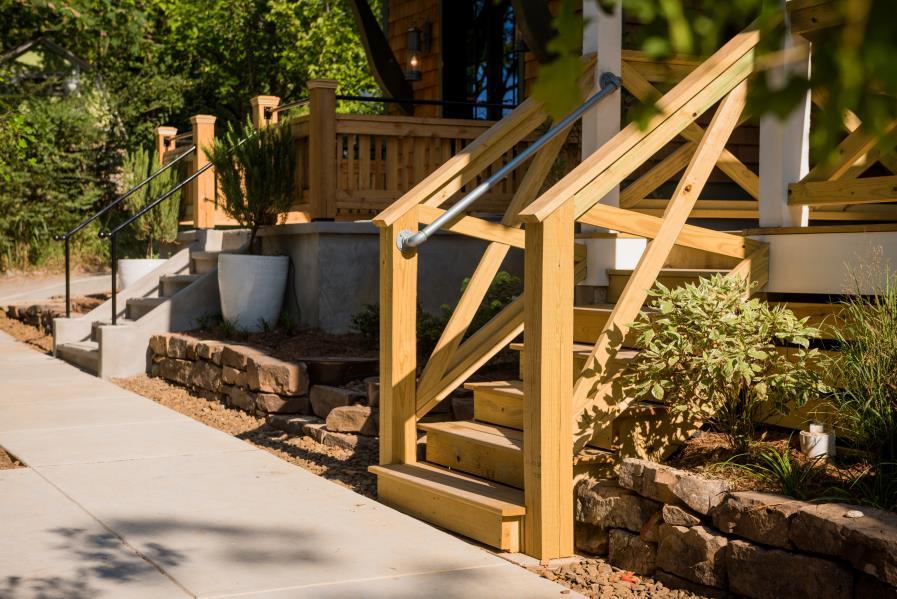
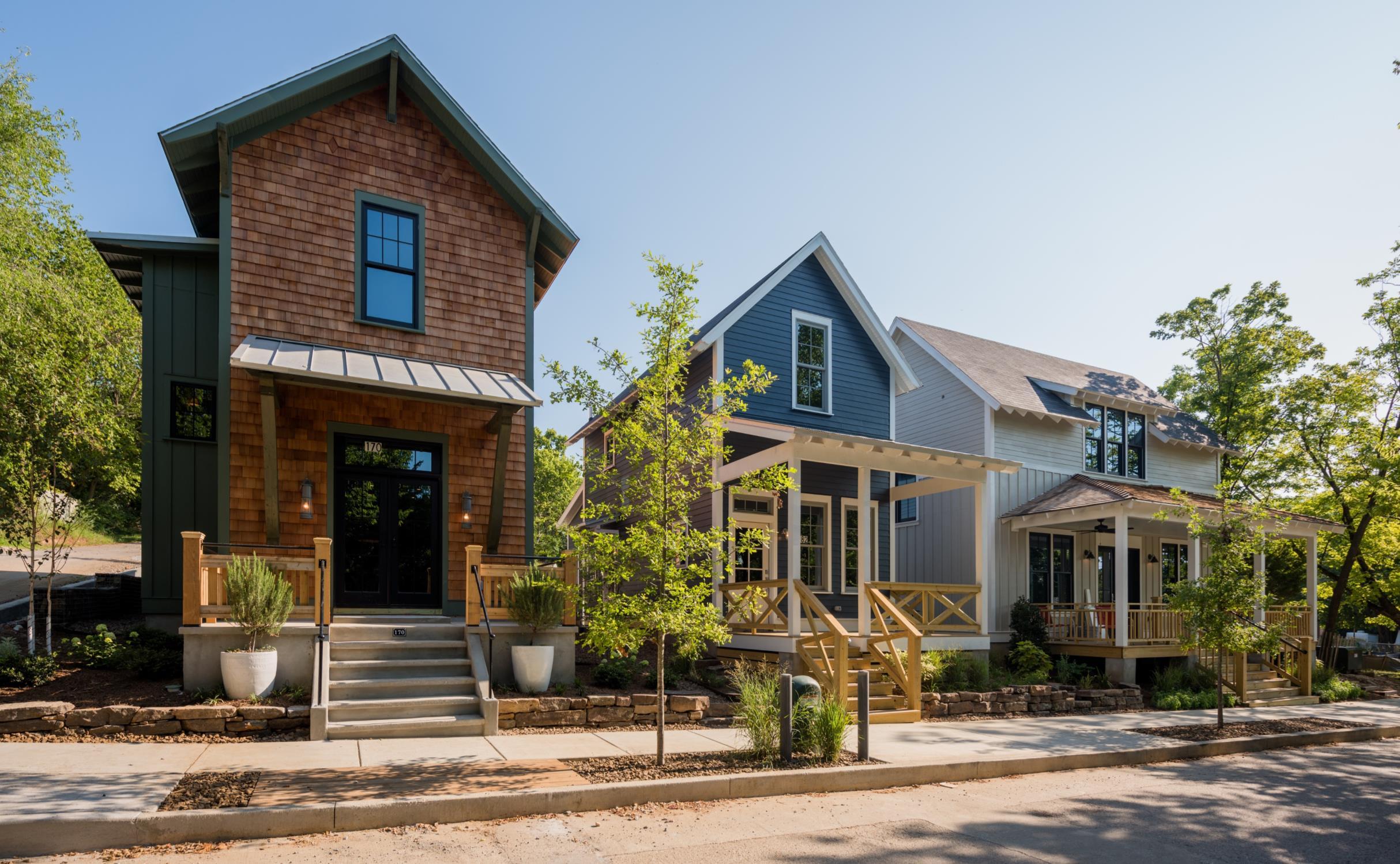
DepartmentofLandscapeArchitecture, FayJonesSchoolofArchitecture+Design, UniversityofArkansas, MeganSuzannReed,NationalCenterfor Preservation,Technology&Training
The roots of Magnolia Plantation trace to a French land grant received on the Red River by Jean Baptiste LeComte I in 1753. Initially, tobacco was the property’s principal crop, but technological advances such as the cotton gin in 1793 (for seed removal) and the screw press in 1801 (for baling) soon led to a boom in cotton production in the region Shrewd decisions by LeComte family members led to their prominence in the area’s labor-intensive cotton industry, fueled by a rapidly expanding enslaved workforce. Magnolia Plantation, established in 1835, was one of several plantations owned by Ambrose LeComte II, greatgrandson of Jean Baptiste. Ambrose II’s unrivaled financial success came at the expense of the largest enslaved labor force in Natchitoches Parish In 1852 Ambrose II gifted a 40% share in Magnolia to his daughter Atala and her new husband, Matthew Hertzog A survey conducted in 1858 depicts numerous structures within Magnolia’s core, including the main house with a treelined allée, 24 two-room slave cabins, slave hospital, smith shop, cook’s house, two stables, two mills, pigeon house, gin barn, and baled cotton barn, among others. While most of Magnolia’s fields were devoted to cotton, about one-third of the acreage under cultivation was planted in corn. Corn was not a market crop but, along with hay, was used to support plantation operations. Sweet potatoes, cowpeas, beans, and sugar cane likely supplemented the corn Ambrose II also raised livestock, most notably racehorses, but also cattle and hogs, along with oxen and mules for use in plantation operations.
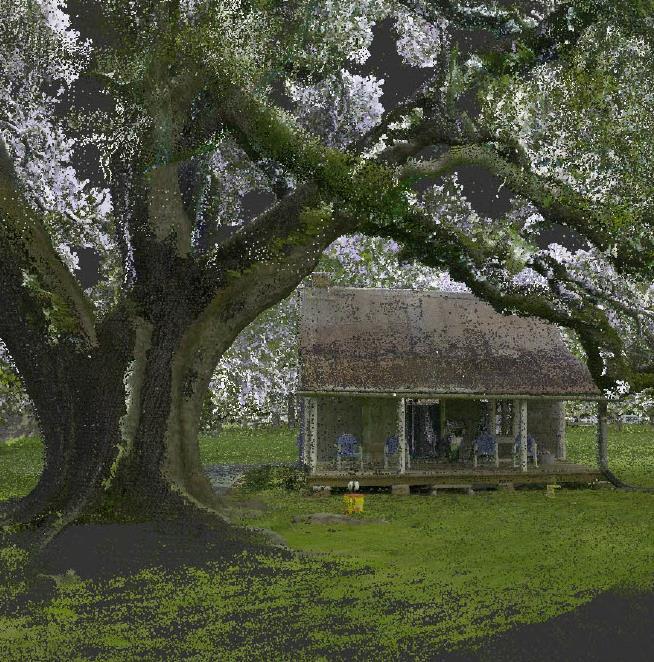
Although the Civil War(1861-1865) ushered in the end of slavery and resulted in the destruction of the original main house, cotton farming continued at Magnolia Plantation with the aid of sharecroppers, tenant farmers, and day laborers, many of whom had formerly been enslaved During this time the Magnolia Plantation Store was built and became a hub of social activity in the area Following Ambrose II’s death in 1883,Atala and Matthew acquired most of the rest of Magnolia’s land, equipment, and livestock. In the 1890s, the couple rebuilt the main house and installed a new gin in the gin barn. Theirs on Ambrose Hertzog assumed ownership and operation of the plantation after Matthew’s death in 1903.
The 20th century brought a host of challenges and a crescendo of change to Magnolia Plantation. A brief cotton boom created by World War I was quickly offset by agricultural depression. In the 1920’s compounded by a boll weevil infestation affecting all American cotton farms and followed by the Great Depression of the 1930’s. Black Americans from the rural
South seeking financial opportunity and relief from racial prejudice began immigrating to northern and western cities, initiating a population shift that became known as the Great Migration. Magnolia Plantation continued operations through these changing times under the direction of Ambrose until he died in 1921 and then under his son Matthew Hertzog II. Advancements in agricultural mechanization offset the shrinking labor force, and 1930’s New Deal policies and programs helped Magnolia Plantation continue producing cotton, corn, hay, cattle, mules, and even racehorses Out-migration and mechanization continued in the 1950s, resulting in the departure of most sharecropper families at Magnolia. The last family living in a former slave cabin moved out in the 1970s. Following Matthew II’s death in 1973, the Hertzog family transferred the land containing the store, slave quarters, and gin barn to Museum Contents Inc. in 1976. The overseer’s house, blacksmith shop, and pigeonnier were also included in the transfer, but the land they stood on was not; the museum planned to move these structures to the property they had received This plan was not carried out, and in 1993 this land was also gifted to Museum Concents Inc All of the museum’s holdings except the parcel containing the store were transferred again in 1996 to Cane River Creole National Historical Park (CARI). The store followed in 1998. In 2018 the Louisiana Department of Transportation and Development closed LA-119 at the store due to a partial collapse of the Cane River Lake embankment. In August 2020, Hurricane Laura destroyed several trees at Magnolia, emphasizing the need to document the landscape more thoroughly
The 2006 and 2021 Magnolia Cultural Landscape Reports (CLR) determined the property was nationally significant based on three criteria defined by the National Register of Historic Places, including Criterion A: Association with events that have made a significant contribution to our history; Criterion C: Embodies the distinctive characteristics of a type, period, or method of construction; and Criterion D: Has yielded or may be likely to yield information important to history or prehistory Criterion A encompasses a broad swath of North American history, from the French and Spanish colonial periods, US antebellum slavery, the Civil War, reconstruction, tenant farming, agricultural industrialization, the Great Migration, and the struggle for Civil Rights. Criterion C addresses Magnolia Plantation as the epitome of a French Creole cotton plantation in the Red River region. Criterion D relates to the archeological potential of the former slave quarters area in particular, but also the site’s former structures, features, and functions
